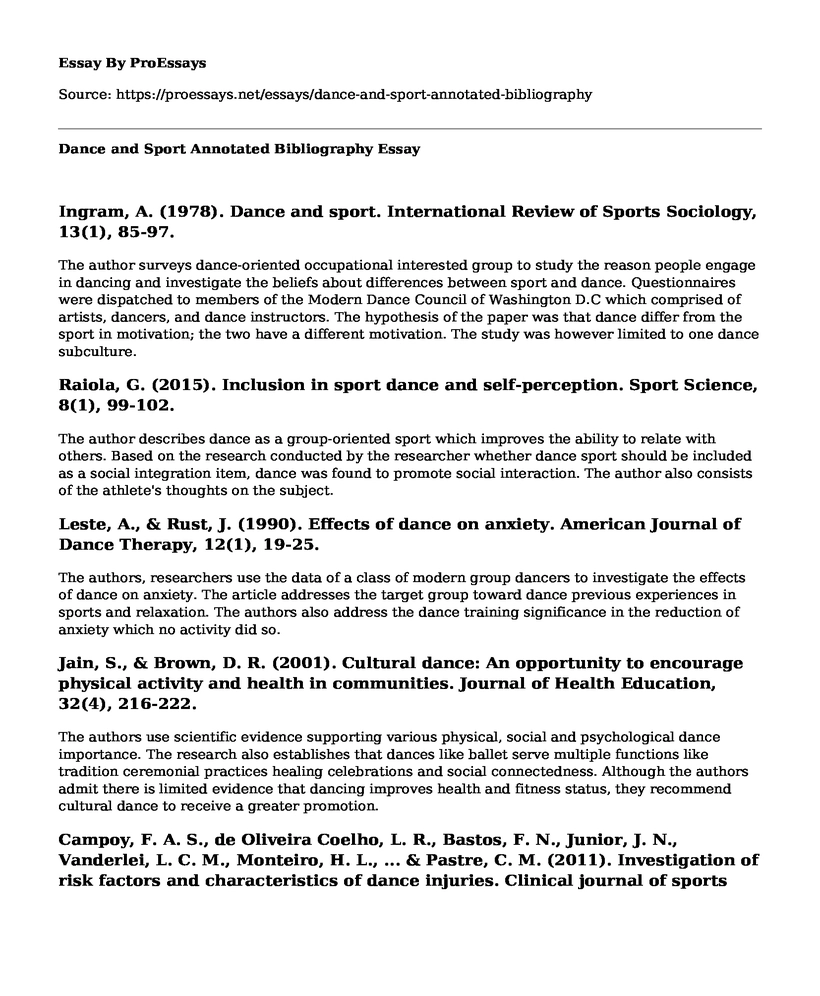Ingram, A. (1978). Dance and sport. International Review of Sports Sociology, 13(1), 85-97.
The author surveys dance-oriented occupational interested group to study the reason people engage in dancing and investigate the beliefs about differences between sport and dance. Questionnaires were dispatched to members of the Modern Dance Council of Washington D.C which comprised of artists, dancers, and dance instructors. The hypothesis of the paper was that dance differ from the sport in motivation; the two have a different motivation. The study was however limited to one dance subculture.
Raiola, G. (2015). Inclusion in sport dance and self-perception. Sport Science, 8(1), 99-102.
The author describes dance as a group-oriented sport which improves the ability to relate with others. Based on the research conducted by the researcher whether dance sport should be included as a social integration item, dance was found to promote social interaction. The author also consists of the athlete's thoughts on the subject.
Leste, A., & Rust, J. (1990). Effects of dance on anxiety. American Journal of Dance Therapy, 12(1), 19-25.
The authors, researchers use the data of a class of modern group dancers to investigate the effects of dance on anxiety. The article addresses the target group toward dance previous experiences in sports and relaxation. The authors also address the dance training significance in the reduction of anxiety which no activity did so.
Jain, S., & Brown, D. R. (2001). Cultural dance: An opportunity to encourage physical activity and health in communities. Journal of Health Education, 32(4), 216-222.
The authors use scientific evidence supporting various physical, social and psychological dance importance. The research also establishes that dances like ballet serve multiple functions like tradition ceremonial practices healing celebrations and social connectedness. Although the authors admit there is limited evidence that dancing improves health and fitness status, they recommend cultural dance to receive a greater promotion.
Campoy, F. A. S., de Oliveira Coelho, L. R., Bastos, F. N., Junior, J. N., Vanderlei, L. C. M., Monteiro, H. L., ... & Pastre, C. M. (2011). Investigation of risk factors and characteristics of dance injuries. Clinical journal of sports medicine, 21(6), 493-498.
The researchers' aim of the study was to identify risk factors which lead to sports injuries in specific dance and training. The information was collected by interviewing dancers on the occurrence of injuries and their nature. As in any sport, the injuries were profound to the regular training routine in terms of intensity, frequency, duration, and form.
Aujla, I., & Farrer, R. (2015). The role of psychological factors in the career of the independent dancer. Frontiers in psychology, 6, 1688.
The authors use the data from the interview carried on 14 dancers at different stages of their career to analyze and reveal that the dancers are highly committed and motivated to their career. The authors argue that through the dancer's motivation in the field, and their tireless training has improved their mental skills to deliver in the demanding sector.
Malkogeorgos, A., Zaggelidou, E., Zaggelidis, G., & Christos, G. (2013). Physiological elements required by dancers. Sport Science Review, 22(5-6), 343-368.
The author describes dancing as an exercise for improving health-related physical fitness that includes muscle flexibility, cardiovascular fitness, and muscular strength. The benefits and quality offered by dancing depend on the forms of dance. The study in this article shows different fitness level in various dances and also in the level of dancers. The author also highlights that dance training have several techniques and training styles that aims to boost skill levels and performance of dancers.
Koutedakis, Y., & Jamurtas, A. (2004). The dancer as a performing athlete. Sports medicine, 34(10), 651-661.
The authors explain that the physical demands required of a dancer make his or her fitness and physiology more critical as skill development. This explains why dancers train hard for their performance. The training exercises improve their fitness and reduce chances of dance injuries. However, the strict selection and training administration has transformed dance practice causing the dancer to have different flexibility characteristics as compared to athletes.
Guarino, L. (2015). Is dance a sport?: A twenty-first-century debate. Journal of Dance Education, 15(2), 77-80.
The consists of debates explaining relationships between dance and sport. It describes how dance was used in ancient as a method of communication and its uses in celebrations, morns and to teach skills. The article also considers dance as a sport since it has since it has some defined rules and availability of dance competition. The author finally accounts dancers train to develop skills.
Best, D. (1985). Sport is not art. Journal of the Philosophy of Sport, 12(1), 25-40.
In this article, the author addresses the confusion between sport and art. He explains dance and drama being artistic since it involves individuals wearing costumes while performing. In art, there are no scoring methods, and the artists focus on the beauty of their article which contrasts with sports aspects. The author points out strongly that dance is an art.
Cite this page
Dance and Sport Annotated Bibliography. (2022, Mar 09). Retrieved from https://proessays.net/essays/dance-and-sport-annotated-bibliography
If you are the original author of this essay and no longer wish to have it published on the ProEssays website, please click below to request its removal:
- Net Neutrality - Essay Example
- Essay on Effects of Social Media on Adolescents
- Eco-Fashion Essay
- Essay Example on The Life of Arnold Schoenberg: An Aussie-American Composer's Rise From Humble Beginnings
- Article Analysis Essay on Closing Rikers Island
- Dancing For Freedom: Expressing Oneself Through Dance - Essay Sample
- Essay Example on Social Media: A Growing Hub for Hackers & Crime







